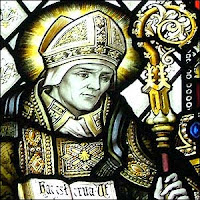Edward Short sent me the link to his
latest for
The Catholic World Report:
It has been more than 50 years since T.S. Eliot died in 1965, and looking back over that period we can see that the decadence he predicted would overtake the West if it chose to abandon its Christian culture has duly arrived. The only thing about our decadence that might have surprised Eliot is the celerity with which it has come—and its thoroughgoingness. If we look at our social, political, cultural, and religious order, we can see how a kind of metastasizing decadence prevails in all of them. By “decadence” I mean what the Oxford English Dictionary means: “The process of falling away or declining (from a prior state of excellence, vitality, prosperity, etc.); decay; impaired or deteriorated condition.” Robert Louis Stevenson once said, “The obscurest epoch is today,” but no amount of obscurity can conceal the fact that if the Christian civilization that Eliot knew was in decline, the one that we know is radically worse. In this essay I shall look at the first four volumes of The Complete Prose of T.S. Eliot to show how Eliot anatomizes this decadence by returning again and again not only to the question of what constitutes Christian civilization but of how best to understand, protect, and revitalize it.
Re: this
project from the Johns Hopkins University Press:
The Complete Prose of T. S. Eliot: The Critical Edition
gathers for the first time in one place the collected, uncollected, and unpublished prose of one of the most prolific writers of the twentieth century. The result of a multi-year collaboration among Eliot's Estate, Faber and Faber Ltd., Johns Hopkins University Press, the Beck Digital Center of Emory University, and the Institute of English Studies, University of London, this eight-volume critical edition dramatically expands access to material that has been restricted or inaccessible in private and institutional collections for almost fifty years.
The fully searchable, integrative edition includes all of Eliot's collected essays, reviews, lectures, commentaries from The Criterion, and letters to editors, including more than 700 uncollected and 150 unpublished pieces from 1905 to 1965. Other highlights include essays from his student years at Smith Academy and Harvard and his graduate work at Harvard and Oxford, including his doctoral dissertation; unsigned, unidentified essays published in the New Statesman and the Monist;
essays and reviews published in the Egoist, Athenaeum, TLS, Dial, Art and Letters;
his Clark and Turnbull lectures on metaphysical poetry, Norton Lectures, Page-Barbour Lectures, Boutwood Lectures; unpublished essays, lectures, addresses from various archives; and transcripts of broadcasts, speeches, endorsements, and memorial tributes.
Each item has been textually edited, annotated, and cross-referenced by an international group of leading Eliot scholars, led by Ronald Schuchard, a renowned scholar of Eliot and Modernism. The volumes will be released in sequence and published on Project MUSE, with an archival print edition to be published once all eight volumes have been released.
Ronald Schuchard, the Goodrich C. White Professor of English, Emeritus, at Emory University, is the author of award-winning Eliot's Dark Angel (1999) and The Last Minstrels: Yeats and the Revival of the Bardic Arts (2008). The editor of Eliot's Clark and Turnbull lectures, The Varieties of Metaphysical Poetry (1993), he is co-editor with John Kelly of The Collected Letters of W. B. Yeats, Volume 3 (1994), Volume 4 (2005), winner of the MLA's Cohen Award for a Distinguished Edition of Letters, and Volume 5 (forthcoming). A former Guggenheim fellow and founder-director of the T. S. Eliot International Summer School (2009-2013), he is a fellow of the American Academy of Arts and Sciences.
Short concludes his essay:
Together, the pieces in this great edition point to the one book that sums up all of Eliot’s work in poetry and prose, Notes Towards the Definition of Culture (1948),
in which he wrote how, “The dominant force in creating a common culture between peoples each of which has its distinct culture, is religion,” though he was quick to assure his readers that he was “not setting out to convert anybody”: he was “simply stating a fact.” In one passage from that prescient volume, he refers to culture as the “incarnation” of a people’s religion, which, in itself, measures how much culture we have lost in losing our religion. In another passage, the Aristotelian critic in Eliot gives full expression to his understanding of the fragility of a culture that will only be replaced at incalculable cost.
It is in Christianity that our arts have developed; it is in Christianity that the laws of Europe have—until recently—been rooted. It is against a background of Christianity that all our thought has significance. An individual European may not believe that the Christian Faith is true, and yet what he says, and makes, and does, will all spring out of his heritage of Christian culture and depend upon that culture for its meaning. Only a Christian culture could have produced a Voltaire or a Nietzsche. I do not believe that the culture of Europe could survive the complete disappearance of the Christian Faith. And I am convinced of that, not merely because I am a Christian myself, but as a student of social biology. If Christianity goes, the whole of our culture goes. Then you must start painfully again, and you cannot put on a new culture ready made. You must wait for the grass to grow to feed the sheep to give the wool out of which your new coat will be made. You must pass through many centuries of barbarism. We should not live to see the new culture, nor would our great-great-great-grandchildren: and if we did, not one of us would be happy in it.
This may be a project mainly for Eliot scholars, but it is an incredible achievement, demonstrating the power of the digital medium. The first four volumes are on-line now, but when the project is complete, there will be real books published!



























